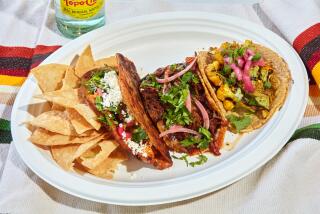Romantic outdoor idyll? Hah!
- Share via
The days are turning cooler, shorter, less brilliant. In a few weeks, nobody will think about picnicking again till spring.
So it’s time to tell you you’ve failed me one more time. I gave you all another chance to straighten up and start picnicking right, but you blew it.
Think of the advantages we have around here -- beaches; mountains; parks; a mild, reliable climate. We can luxuriate in the scent of pine needles or new-mown grass or the primeval sea, while enjoying our food with that special sharpness and savor you get only outdoors.
So how are we showing our appreciation of these privileges, for which millions around the world envy us? By the muddled, fizzling way we picnic. Just look around. You’ll see us hauling our picnic food in paper bags, plastic buckets and ratty foam coolers with the corners crumbling off.
Whatever happened to the romance of the outdoor meal? The idyllic alfresco feast every contestant on “The Bachelorette” yearns for? The restoration of the weary soul in the bosom of nature, and all that stuff?
The problem, it seems to me, comes down to the demise of the picnic basket.
The more organized are using New Age food carriers based on the backpack, complete with shoulder straps, bulging zippered pockets and bright panels of ripstop nylon. They look like toaster ovens wrapped in jogging suits. Some models have wheels, like carry-on luggage.
Everybody says these buckets and coolers and backpacks are practical, but yikes, everybody, what a way to picnic! It’s like getting married in ski boots -- sure, there are people who do it, but yikes!
The picnic basket -- the real thing, woven out of reeds or twigs or thin strips of wood -- is the proven conveyance, and it’s something that ties you to centuries of picnics past.
Throughout history, baskets were the everyday way to carry all sorts of things, above all food. For a long time, these weren’t picnic baskets -- they were unspecialized, everyday baskets without lids. Well into the 19th century, picnickers often carried the same kind of basket they’d use for shopping or berry-picking and just covered the food with a cloth, a la Red Riding Hood.
One of the earliest illustrations of a European picnic is a woodcut dating from about 1600. It shows Elizabeth I seated under a tree with a tablecloth spread in front of her. You can make out chickens, geese and pies on the cloth, and you also can see the basket the food had been brought in -- a big, lidless hamper that had a handle at each end because it took two men to carry it.
The queen’s caterer had not skimped on the wine, either. There were two barrels of wine at this picnic, making it a sort of Renaissance kegger.
About 1750, the French painter Carle van Loo painted “The Hunting Luncheon,” showing a party of aristocrats enjoying a fine spread of meat: a whole ham, a round of beef and what looks like roast rabbit. Or maybe this is just what’s left by the time of the painting; from the debris on the plates there might have been other things such as oysters. The aristos are eating off of fine china, and a servant is hauling stuff around in a big rectangular basket. It looks like fun, except for the fact that people like you and me would never have been invited by this crowd, even if we had a set of silk knee breeches.
Francisco Goya’s “Merienda Campestre,” painted in 1788, depicts a less exalted gathering of Spanish ladies and gentlemen picnicking on a cloth spread under a tree.
The picnic always has been a perfect set-up for romance -- in Charles Dickens’ novels we think of David Copperfield’s desperate struggle to separate Dora from the rival who’s trying to charm her with his salad-making abilities. In this particular painting of Goya’s, you distinctly feel the two picnickers who are flirting hardest are going to regret it when they sober up.
In the early 19th century, the English Romantics liked rambling in wild places with a simple basket of food. It was Wordsworth’s favorite way to entertain. Not everybody was so intent on communing with nature -- Jane Austen’s people certainly packed more than an apple and a bottle of wine -- but for the English there remained a certain spirituality and high-mindedness about eating outdoors.
For the French, not so much. Edouard Manet’s famous “Dejeuner sur l’Herbe” (1863) shows a naked Parisienne blithely picnicking with two clothed men. In the left foreground, on top of her blue dress, lies an everyday wicker basket, the sort that she might have taken with her to the fruit market. In fact, maybe she had just come from the fruit market, because peaches, plums, brownish pears and large cherries are spilling out of the basket, along with a round loaf of bread.
They went all out
Across the channel in England, the picnic was entering its golden age in the 1860s. Although it had been a simple back-to-nature thing, it was becoming much more elaborate. The first edition of Isabella Beeton’s “Book of Household Management” (1861) presumes 40 guests at your picnic, so she says to bring roast beef, boiled beef, two racks of lamb, two shoulders of lamb, four roast chickens, two ducks, a ham, a tongue, four meat pies, half a dozen lobsters, six baskets of salad and a few more of fruit, four dozen cheesecakes, six cakes and six pounds of butter. In case people get thirsty, you’ll need three dozen quarts of ale, six bottles of wine and Champagne, brandy and lemonade.
Needless to say, this meant having lots of baskets. Fortunately, specialized picnic baskets were being manufactured in England. One company founded in 1864, Gadsby Hampers & Basketware, still is very much in business.
At first, the picnic basket had been just any basket big enough to hold your food, dishware and tablecloths, but in Victorian times it became a huge thing with a lid that could be latched down, like the gigantic suitcases of the day that were almost portable closets. The late 19th and early 20th century picnic hamper, dainty though it might appear, was ready for every eventuality, with dishes and tableware strapped into the lid and room for all sorts of sandwich containers and condiment bottles, even a little burner for heating the tea kettle.
“These hampers may be cumbersome,” wrote Elizabeth David in 1955, “but they are capacious and solid; an aura of lavish gallivantings and ancient Rolls-Royces hangs about them, and they are infinitely superior to the modern kind in which the use of every inch of space has been planned for you in advance.”
Personally, I don’t need an aura of Rolls-Royces, but it does seem to me that the picnic is about leisurely enjoyment, the sort you ought to be willing to work for. If it’s convenience you value, if it’s too much trouble to carry a simple woven basket, you might as well stay home.


